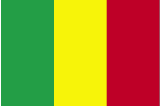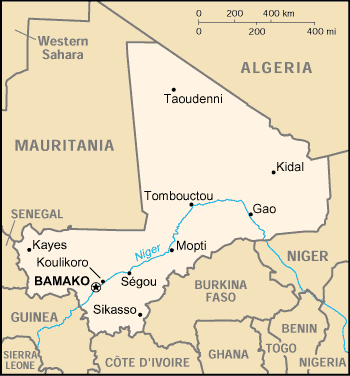|
Mali
|

|
Capital: Bamako
Population: 19,658,031
Brief History of Mali:
The land of Mali was once home to some of the great African Empires. Ghana Empire was the first to emerge around 700 AD. It ruled the area until 1075 and became an important trading state. In the 11th century the Malinke Kingdom rose to power. It reached its height in 1325 when it conquered Timbuktu and Gao. In 1465 the Songhai Empire took control. It reached its peak under a ruler named Askia Mohammad I and its main city, Timbuktu, became a center of commerce and Islam. The Songhai Empire was destroyed by the Moroccans in 1591.
The French colonized the area in the late 1800s. They controlled the area until 1960 when the Sudanese Republic and Senegal formed the Mali Federation and became independent of France. Senegal withdrew from the federation after a few months and the Republic of Mali became its own independent country.
The Geography of Mali
Total Size: 1,240,000 square km
Size Comparison: slightly less than twice the size of Texas
Geographical Coordinates: 17 00 N, 4 00 W
World Region or Continent: Africa
General Terrain: mostly flat to rolling northern plains covered by sand; savanna in south, rugged hills in northeast
Geographical Low Point: Senegal River 23 m
Geographical High Point: Hombori Tondo 1,155 m
Climate: subtropical to arid; hot and dry (February to June); rainy, humid, and mild (June to November); cool and dry (November to February)
Major cities: BAMAKO (capital) 1.628 million (2009), Sikasso
The People of Mali
Type of Government: republic
Languages Spoken: French (official), Bambara 80%, numerous African languages
Independence: 22 September 1960 (from France)
National Holiday: Independence Day, 22 September (1960)
Nationality: Malian(s)
Religions: Muslim 90%, indigenous beliefs 9%, Christian 1%
National Symbol:
National Anthem or Song: Le Mali (Mali)
Economy of Mali
Major Industries: food processing; construction; phosphate and gold mining
Agricultural Products: cotton, millet, rice, corn, vegetables, peanuts; cattle, sheep, goats
Natural Resources: gold, phosphates, kaolin, salt, limestone, uranium, gypsum, granite, hydropower
Major Exports: cotton, gold, livestock
Major Imports: petroleum, machinery and equipment, construction materials, foodstuffs, textiles
Currency: Communaute Financiere Africaine franc (XOF); note - responsible authority is the Central Bank of the
National GDP: $17,880,000,000
** Source for population (2012 est.) and GDP (2011 est.) is CIA World Factbook.
Back to Geography Home Page
